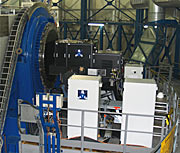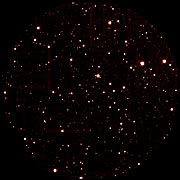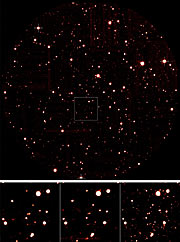Tisková zpráva
New Adaptive Optics Technique Demonstrated
First ever Multi-Conjugate Adaptive Optics at the VLT Achieves First Light
30. března 2007
On the evening of 25 March 2007, the Multi-Conjugate Adaptive Optics Demonstrator (MAD) achieved First Light at the Visitor Focus of Melipal, the third Unit Telescope of the Very Large Telescope (VLT). MAD allowed the scientists to obtain images corrected for the blurring effect of atmospheric turbulence over the full 2x2 arcminute field of view. This world premiere shows the promises of a crucial technology for Extremely Large Telescopes.
Telescopes on the ground suffer from the blurring effect induced by atmospheric turbulence. This turbulence causes the stars to twinkle in a way which delights the poets but frustrates the astronomers, since it blurs the fine details of the images.
However, with Adaptive Optics (AO) techniques, this major drawback can be overcome so that the telescope produces images that are as sharp as theoretically possible, i.e., approaching space conditions. Adaptive Optics systems work by means of a computer-controlled deformable mirror (DM) that counteracts the image distortion induced by atmospheric turbulence. It is based on real-time optical corrections computed from image data obtained by a 'wavefront sensor' (a special camera) at very high speed, many hundreds of times each second.
The concept is not new. Already in 1989, the first Adaptive Optics system ever built for Astronomy (aptly named "COME-ON") was installed on the 3.6-m telescope at the ESO La Silla Observatory, as the early fruit of a highly successful continuing collaboration between ESO and French research institutes (ONERA and Observatoire de Paris). Ten years ago, ESO initiated an Adaptive Optics program to serve the needs for its frontline VLT project. Today, the Paranal Observatory is without any doubt one of the most advanced of its kind with respect to AO with no less than 7 systems currently installed (NACO, SINFONI, CRIRES and four AO systems for the interferometric mode of the VLT).
Present AO systems can only correct the effect of atmospheric turbulence in a relative small region of the sky - typically 15 arcseconds, the correction degrading very quickly when moving away from the central axis. Engineers have therefore developed new techniques to overcome this limitation, one of which is multi-conjugate adaptive optics (MCAO). At the end of 2003, ESO, together with partners in Italy and Portugal, started the development of a MCAO Demonstrator, named MAD.
"The aim of MAD is to prove the feasibility and performances of new adaptive optics techniques, such as MCAO, meant to work on large fields of view and to serve as a very powerful test tool in understanding some of the critical issues that will determine the development of future instruments, for both the VLT and the Extremely Large Telescopes," said Norbert Hubin, head of the AO group at ESO.
MAD is an advanced generation adaptive optics system, capable of compensating for the atmospheric turbulence disturbance on a large field of view (FoV) on the sky. It can successfully correct a 1-2 arcmin FoV, much larger than the ~15 arcsec typically provided by the existing adaptive optics facilities.
MAD was fully developed and extensively characterized by ESO using a dedicated turbulence generator (MAPS, Multi Atmospheric Phase screens and Stars) able to reproduce in the laboratory the temporal evolution and the vertical structure of the turbulence observed at the Observatory.
MAD was then disassembled and shipped to Paranal for re-integration at the Nasmyth Visitor focus of UT3. The integration took about 1 month, after which the system was ready for daylight testing and further characterization.
"On the night of 25 March, we could successfully close the first MCAO loop on the open cluster NGC 3293," said Enrico Marchetti, the MAD Project Manager. "The system behaviour was very stable and the acquisition and closed loop operations were fast and smooth."
After routine checks on the closed loop stability and preliminary scans of the system parameters, the telescope was pointed to Omega Centauri, a very crowded area in the sky, and an optimal test case for extracting accurate measurements on AO correction performance with good spatial resolution on the FoV. Three 11 magnitude stars within a circle of ~1.5 arcmin diameter were selected as the baseline for wavefront sensing and the MCAO loop was closed successfully. Omega Centauri will be observed for several nights more, in order to test the AO correction in different seeing conditions.
"This is a tremendous achievement that opens new perspectives in the era of extremely large telescopes," said Catherine Cesarsky, ESO's Director General. " "I am very proud of the ESO staff and wish to congratulate all involved for their prowess," she added.
The MAD images perfectly show the validity of the concept. The image quality was almost uniform over the whole field of view and beautifully corrected for some of the atmospheric turbulence.
Další informace
The Multi-Conjugate Adaptive Optics (MCAO) Demonstrator MAD was built by ESO in collaboration with the Astronomical Observatories of Arcetri and Padova (Italy) and the Faculdade de Ciencias da Universidade de Lisboa (Portugal), as a pathfinder for 2nd generation VLT instrumentation and the European Extremely Large Telescope project.
The MCAO technique is based on probing the atmospheric turbulence on a large volume of atmosphere by means of several wavefront sensors (WFS), which point at different locations in the observed field of view, and by means of several deformable mirrors - optically conjugated at different altitudes on the atmosphere above the telescope - which correct for the atmospheric disturbance. The signals provided by the wavefront sensors are reconstructed to generate accurate information on the vertical structure of the atmospheric turbulence and then recombined in an optimal way to accomplish the best correction with the deformable mirrors located in the AO system. Since the wavefront sensors look at different directions in the field of view, the resulting correction is then optimized and homogeneously maximized across it. MAD makes use of two deformable mirrors, optically conjugated at 0 and 8.5 kilometres above the telescope.
Kontakty
Enrico Marchetti
ESO
Garching, Germany
Tel.: +49 89 3200 6458
Email: emarchet@eso.org
Norbert Hubin
ESO
Garching, Germany
Tel.: +49 89 3200 6517
Email: nhubin@eso.org
O zprávě
| Tiskové zpráva č.: | eso0719 |
| Legacy ID: | PR 19/07 |
| Jméno: | MAD |
| Typ: | Unspecified : Technology : Observatory : Instrument |
| Facility: | Very Large Telescope |
| Instruments: | ESO Multi-conjugate Adaptive optics Demonstrator (MAD) |
Our use of Cookies
We use cookies that are essential for accessing our websites and using our services. We also use cookies to analyse, measure and improve our websites’ performance, to enable content sharing via social media and to display media content hosted on third-party platforms.
ESO Cookies Policy
The European Organisation for Astronomical Research in the Southern Hemisphere (ESO) is the pre-eminent intergovernmental science and technology organisation in astronomy. It carries out an ambitious programme focused on the design, construction and operation of powerful ground-based observing facilities for astronomy.
This Cookies Policy is intended to provide clarity by outlining the cookies used on the ESO public websites, their functions, the options you have for controlling them, and the ways you can contact us for additional details.
What are cookies?
Cookies are small pieces of data stored on your device by websites you visit. They serve various purposes, such as remembering login credentials and preferences and enhance your browsing experience.
Categories of cookies we use
Essential cookies (always active): These cookies are strictly necessary for the proper functioning of our website. Without these cookies, the website cannot operate correctly, and certain services, such as logging in or accessing secure areas, may not be available; because they are essential for the website’s operation, they cannot be disabled.
Functional Cookies: These cookies enhance your browsing experience by enabling additional features and personalization, such as remembering your preferences and settings. While not strictly necessary for the website to function, they improve usability and convenience; these cookies are only placed if you provide your consent.
Analytics cookies: These cookies collect information about how visitors interact with our website, such as which pages are visited most often and how users navigate the site. This data helps us improve website performance, optimize content, and enhance the user experience; these cookies are only placed if you provide your consent. We use the following analytics cookies.
Matomo Cookies:
This website uses Matomo (formerly Piwik), an open source software which enables the statistical analysis of website visits. Matomo uses cookies (text files) which are saved on your computer and which allow us to analyze how you use our website. The website user information generated by the cookies will only be saved on the servers of our IT Department. We use this information to analyze www.eso.org visits and to prepare reports on website activities. These data will not be disclosed to third parties.
On behalf of ESO, Matomo will use this information for the purpose of evaluating your use of the website, compiling reports on website activity and providing other services relating to website activity and internet usage.
Matomo cookies settings:
Additional Third-party cookies on ESO websites: some of our pages display content from external providers, e.g. YouTube.
Such third-party services are outside of ESO control and may, at any time, change their terms of service, use of cookies, etc.
YouTube: Some videos on the ESO website are embedded from ESO’s official YouTube channel. We have enabled YouTube’s privacy-enhanced mode, meaning that no cookies are set unless the user actively clicks on the video to play it. Additionally, in this mode, YouTube does not store any personally identifiable cookie data for embedded video playbacks. For more details, please refer to YouTube’s embedding videos information page.
Cookies can also be classified based on the following elements.
Regarding the domain, there are:
- First-party cookies, set by the website you are currently visiting. They are stored by the same domain that you are browsing and are used to enhance your experience on that site;
- Third-party cookies, set by a domain other than the one you are currently visiting.
As for their duration, cookies can be:
- Browser-session cookies, which are deleted when the user closes the browser;
- Stored cookies, which stay on the user's device for a predetermined period of time.
How to manage cookies
Cookie settings: You can modify your cookie choices for the ESO webpages at any time by clicking on the link Cookie settings at the bottom of any page.
In your browser: If you wish to delete cookies or instruct your browser to delete or block cookies by default, please visit the help pages of your browser:
Please be aware that if you delete or decline cookies, certain functionalities of our website may be not be available and your browsing experience may be affected.
You can set most browsers to prevent any cookies being placed on your device, but you may then have to manually adjust some preferences every time you visit a site/page. And some services and functionalities may not work properly at all (e.g. profile logging-in, shop check out).
Updates to the ESO Cookies Policy
The ESO Cookies Policy may be subject to future updates, which will be made available on this page.
Additional information
For any queries related to cookies, please contact: pdprATesoDOTorg.
As ESO public webpages are managed by our Department of Communication, your questions will be dealt with the support of the said Department.





